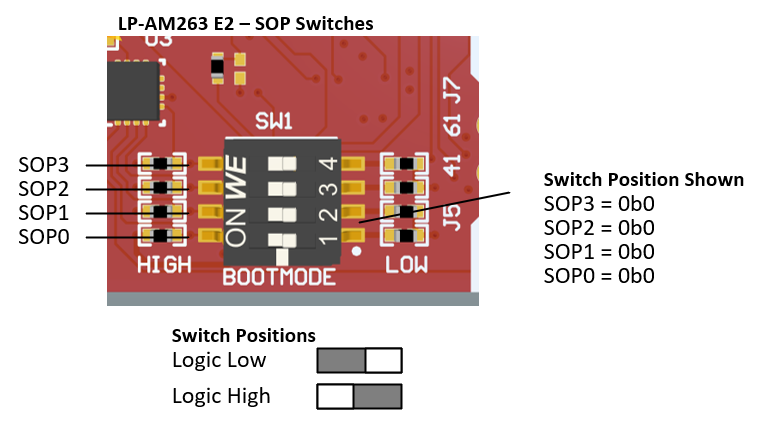SPRUJ10D May 2022 – September 2023
- 1
- Abstract
- Trademarks
- 1Preface: Read This First
- 2Kit Overview
- 3Board Setup
-
4Hardware Description
- 5.1 Functional Block Diagram
- 5.2 GPIO Mapping
- 5.3 Reset
- 5.4 Clock
- 5.5 Memory Interface
- 5.6 Ethernet Interface
- 5.7 I2C
- 5.8 Industrial Application LEDs
- 5.9 SPI
- 5.10 UART
- 5.11 MCAN
- 5.12 FSI
- 5.13 JTAG
- 5.14 Test Automation Header
- 5.15 LIN
- 5.16 MMC
- 5.17 ADC and DAC
- 5.18 EQEP and SDFM
- 5.19 EPWM
- 5.20 BoosterPack Headers
- 5.21 Pinmux Mapping
- 5References
- 6Revision History
3.3 Boot Mode Selection
The bootmode for the AM263x is selected by a DIP switch (SW1) or the test automation header. The test automation header uses an I2C expansion buffer to drive the bootmode when PORz is toggled. The supported boot modes are shown in Table 3-6. The DIP Switch configurations for each bootmode are shown in Table 3-5.
 Figure 3-6 Bootmode DIP Switch
Positions
Figure 3-6 Bootmode DIP Switch
PositionsTable 3-5 Boot-Mode
Selection
| Boot Mode | SPI0_D0_pad (SOP3) | SPI0_CLK_pad (SOP2) | QSPI_D1 (SOP1) | QSPI_D0 (SOP0) |
|---|---|---|---|---|
| QSPI (4S) - Quad Read Mode | 1 | 1 | 1 | 1 |
| UART | 1 | 1 | 1 | 0 |
| QSPI (1S) - Single Read Mode | 1 | 1 | 0 | 1 |
| QSPI (4S) - Quad Read UART Fallback Mode | 1 | 0 | 1 | 1 |
| QSPI (1S) - Single Read UART Fallback Mode | 1 | 0 | 1 | 0 |
| DevBoot | 0 | 1 | 0 | 0 |
| Unsupported Boot Mode | All other combinations not defined above | |||
Table 3-6 Supported Boot
Modes
| Boot Mode/Peripheral | Boot Media/Host | Notes |
|---|---|---|
| QSPI (4S) - Quad Read Mode | QSPI Flash | Download and boot SBL from QSPI flash in quad read mode. Attempt Primary SBL, followed by Secondary SBL if primary loading fails. |
| UART | External Host | Download and boot SBL from UART. Device is expected to get SBL from UART. Device supports the XMODEM protocol for download over UART. |
| QSPI (1S) - Single Read Mode | QSPI Flash | Download and boot SBL from QSPI flash in single read mode. Attempt Primary SBL,followed by Secondary SBL if primary loading fails. |
| QSPI (4S) - Quad Read UART Fallback Mode | QSPI Flash / External Host | Download and boot SBL from QSPI flash in quad read mode. Attempt Primary SBL, followed by Secondary SBL if primary loading fails. If Secondary SBL also fails then boot from external host via UART interface. |
| QSPI (1S) - Single Read UART Fallback Mode | QSPI Flash / External Host | Download and boot SBL from QSPI flash in single read mode. Attempt Primary SBL, followed by Secondary SBL if primary loading fails. If Secondary SBL also fails then boot from external host via UART interface. |
| DevBoot | N/A | No SBL. Used for development purposes only. |